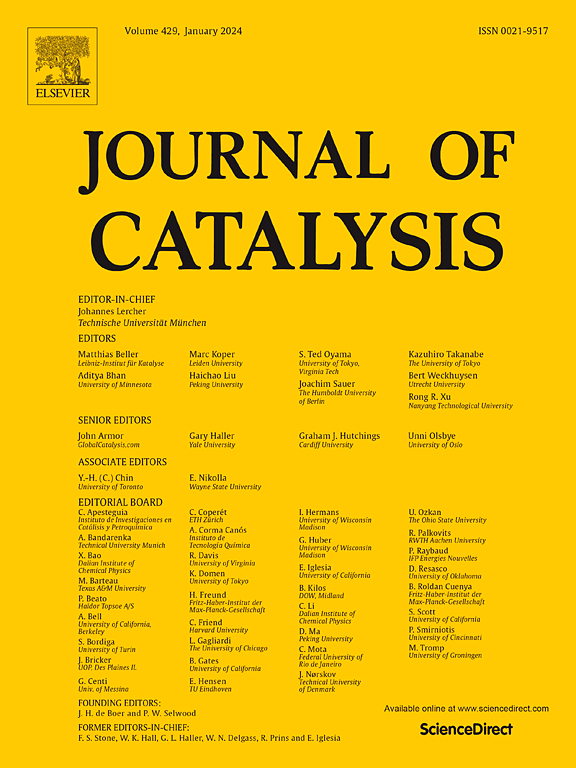D-A配体的扩展π共轭使得一种cu基杂化化合物成为四环素的敏感荧光传感器和高效光降解催化剂
IF 6.5
1区 化学
Q2 CHEMISTRY, PHYSICAL
引用次数: 0
摘要
显色配体的合理选择和设计是提高有机 − 无机杂化材料光致发光和光催化性能的关键。本文设计并制备了D − a型希夫碱配体N-(蒽-9-基亚甲基)吡嗪-2-胺(AIPZ),该配体驱动一维CuI杂化化合物1D-CuI(AIPZ)的生成。虽然2D-CuI(APZ)和1D-CuI(AIPZ)都配备了一维CuI模块,但光致发光研究和光电子性能测量表明,后者具有优化的能带结构,增强的光致发光行为,以及更高的载流子分离和转移能力。值得注意的是,1D-CuI(AIPZ)可以作为双功能材料用于选择性荧光检测四环素(TC),在黑暗中检测限为0.261 µM,在可见光照射下60 min内光催化去除94.14% %的污染物。通过实验与理论相结合的方法,揭示了AIPZ的扩展D − A结构对1D-CuI(AIPZ)优于2D-CuI(APZ)的光致发光效率和光催化活性的贡献。此外,1D-CuI(AIPZ)在含TC废水的检测和光催化处理方面的良好适用性通过两个实验事实得到验证:在实际水基质中监测TC的令人满意的回收率,在自然光照射下保持超过70% %的TC降解率。这项工作提供了一种可行的配体工程方法来整合和优化有机 − 无机杂化材料对常见环境污染物的荧光检测和光催化去除能力。本文章由计算机程序翻译,如有差异,请以英文原文为准。


Extended π-conjugation of D–A ligand enabling a CuI-based hybrid compound as sensitive fluorescent sensor and efficient photodegradation catalyst for tetracycline
The judicious selection and rational design of the chromogenic ligands are deemed as a critical aspect to enhance the photoluminescent and/or photocatalytic performance of organic–inorganic hybrid materials. Here, a D–A type Schiff-base ligand, N-(anthracen-9-ylmethylene)pyrazine-2-amine (AIPZ) was deliberated-designed and prepared which drives the generation of a one-dimensional CuI hybrid compound, 1D-CuI(AIPZ). Though both 2D-CuI(APZ), a two-dimensional CuI-based hybrid from 2-aminopyrazine (APZ), and 1D-CuI(AIPZ) are equipped with one-dimensional CuI modules, the photoluminescence studies and optoelectronic property measurements disclosed that the latter features the optimized energy band structure, intensified photoluminescent behavior, and higher carrier separation and transfer ability. Remarkably, 1D-CuI(AIPZ) is competent as a bifunctional material for selective fluorescent detection of tetracycline (TC) with 0.261 µM detection limit in the dark, and photocatalytically eliminating 94.14 % of this pollutant within 60 min under visible light irradiation. The insight into the contribution of the extended D–A structure of AIPZ on the superior photoluminescence efficiency and photocatalytic activity of 1D-CuI(AIPZ) than 2D-CuI(APZ) was established by the combined experimental and theoretical approaches. Moreover, the promising applicability of 1D-CuI(AIPZ) for the detection and photocatalytic treatment of TC-containing wastewater was validated by two experimental facts: the satisfactory recovery rate for monitoring TC in real water matrices, the preservation of more than 70 % of degradation rate for TC irradiated by the natural light. This work offers a feasible ligand-engineering approach to integrate and optimize the fluorescent detection and photocatalytic removal abilities of the organic–inorganic hybrid materials for common environmental pollutants.
求助全文
通过发布文献求助,成功后即可免费获取论文全文。
去求助
来源期刊

Journal of Catalysis
工程技术-工程:化工
CiteScore
12.30
自引率
5.50%
发文量
447
审稿时长
31 days
期刊介绍:
The Journal of Catalysis publishes scholarly articles on both heterogeneous and homogeneous catalysis, covering a wide range of chemical transformations. These include various types of catalysis, such as those mediated by photons, plasmons, and electrons. The focus of the studies is to understand the relationship between catalytic function and the underlying chemical properties of surfaces and metal complexes.
The articles in the journal offer innovative concepts and explore the synthesis and kinetics of inorganic solids and homogeneous complexes. Furthermore, they discuss spectroscopic techniques for characterizing catalysts, investigate the interaction of probes and reacting species with catalysts, and employ theoretical methods.
The research presented in the journal should have direct relevance to the field of catalytic processes, addressing either fundamental aspects or applications of catalysis.
 求助内容:
求助内容: 应助结果提醒方式:
应助结果提醒方式:


